Making truly delicious olive oil and table olives starts in the groves, where we spend all year raising the best possible crop for our products. This page discusses Takao Olive Farm’s growing process in depth, to give a behind-the-scenes look at not just what we do, but the how and why as well.
Our aim at Takao Olive Farm is to grow our olives in harmony with nature, with the safest cultivation practices for the earth, farmers, crops, and of course, our customers. For the future of olive farming, we want to share the joy we feel every day here on our farm.
The Olive Farm’s Record-keeping
Observation & Study
For continuous learning & improvement
There are many factors that support healthy olive trees, such as their surroundings, space between the trees, the color and thickness of leaves, weeds and vegetation growth, temperature, precipitation… pretty much everything around them. Most of these are up to nature, but there are also factors that we can help along with a little extra understanding, like soil conditions, fertilization, and irrigation.
Our olive farm is spread out over seven different groves, and each one gets different sunlight and wind exposure, has different soil composition, and has differing access to groundwater. We consider all these elements carefully as we study the best way to maintain our olive groves. We also draw on resources like weather forecasts, seasonal change predictions, as well as utilize lunar rhythms based on the traditional lunar calendar. All these come together to help us plan out our cultivation and work schedules, and give our olive trees the best possible care.
All our research compounds to create a large bank of knowledge and experience to draw on as we strive for continuous improvement year after year.

Adjusting tree distance by pruning 
Adjusting tree distance by pruning 
Testing direct sunlight hours 
Irrigation by tube

Olive fruits in mid-August 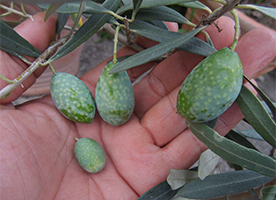
Checking infant olives and leaves 
Checking olives and leaves 
Composting pruning materials
Weeding & Vegetation
It would be easier to use herbicides, but…
There are definitely times where we think, “Herbicide would make things so much easier.” But since we strive to use as few chemicals as possible, we cut back vegetation on the groves four times a year. We use a variety of equipment, like weed whackers and mowers, but also do the areas closest to the trees by hand. The grasses and plants we cut are left where they fall, which actually contributes to a healthy grove. The organic matter released as the vegetation decomposes returns essential nutrients to the soil, as well as prevents soil erosion on uneven grove surfaces.
The fallen grass also keeps tree roots from becoming waterlogged, and absorbs evaporation from the olive leaves. During the rainy times of year, leftover grass helps absorbs excess rainwater, and once the rains abate, we get back out and do a thorough weeding again. During the very hot months in the summer, the weeds and the olive trees fight for access to water, so we make sure to do a cut back just before water access becomes critical. This is the most labor-intensive part of the year, and it really is us versus the weeds and sun in a test of strength.

Cleaning up around the trees 
Using a mower 
Using a weed whacker to cut back grass 
Mowing in summer
Pests & Disease
To protect our olives
Many living creatures, including us humans, and plants spend their lives in the olive groves. Some of these creatures, especially insects, come because they like olives the most. Some of these unwelcome guests are Komori moths, drone beetles, wood borers, olive weevils, caterpillars, and even deer come to make a meal of our olive trees. Olives are also susceptible to olive knot disease and anthrax infection,
Outside of pests, trees can also be damaged depending on their type or weather conditions, and sometimes we are unable to harvest any fruits from them. To best protect trees, we try to create the best possible environment for them through preventative measures like weeding, weed proofing, pruning, and other methods. Regulations permit 8 types of agricultural chemicals to be used up to 25 times per year, but at Takao Olive Farm, we use one type (to prevent olive weevils) 3 times a year only. We carefully observe agricultural regulations and record each application.
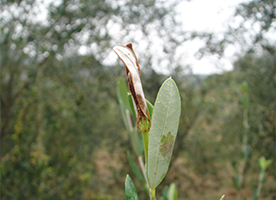
Damage from Leaf Rollers 
Damage from Komori moths 
Damage from olive weevils 
Study of anthracnose
Soil Preparation
For raising healthy olive trees
The main components of our olive fertilizer come from organic animal sources (such as chicken/cow manure and oyster shells) as well as plant sources (oil lees.) We also test out bean-and rice-derived green manure fertilizers along the way. Green manure is made from plants we grow just to till up and leave in the soil to decompose, and it also helps to prevent weed growth and improves soil mineral content. We spread out our organic fertilizers, plant cover crops, and let vegetation cuttings decompose and fertilize the soil. Olive tree roots need a lot of oxygen, so we also try to create soil with good airflow. This is good not only for the trees, but for the living organisms in the soil as well.

Prepping chicken manure fertilizer 
Bags of fertilizer 
Testing soil pH 
Green manure hairy vetch
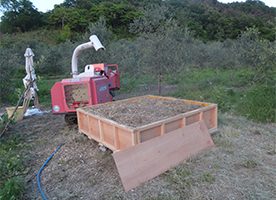
Compost making by a pruning residual 
Cover crop seedlings 
Dichondra seeds 
Green manure, barley seeding
Machinery & Implements
Our friends on the farm
All our farming implements, whether old ones that have stood the test of time or modern machinery, are important colleagues in our work. We do our best to keep all our equipment in the best condition. Before we put anything away after use, we make sure each cutter gets sharpened and every spade is cleaned. With machinery, we check them over well so that oil leaks don’t contaminate the olive groves. We also take special care to use minimal fuel, biodiesel where possible, and also decrease our emissions where we can.

Weed cutters 
Tripod for harvesting and pruning 
Pruning scissors and saw 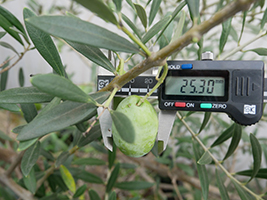
Measuring instrument
The Olive Farm’s Cultivation Record-keeping
We currently have seven groves and one sapling nursery. Each olive grove gets broken up into small areas, with numbers assigned to each space: Kurikidani (No. A-K, No. 1-8, No. 11-15 total 24 areas), Jorakubo (No. 1-8, No 10-12 total 11 areas), Yamanokami (No.1 & 2 total 2 areas), Nakayasumi (No. 1-6 total 6 areas), Hama (1 area), Teranoshita (1 area), Nishinotani (1 area), and Ume Olive Nursery (1 area). Every day, we keep careful records of the main work and cultivation conducted in each area. This helps us understand grove patterns and gives us greater understanding of our farming practices.

Work & Time record 
Work Diary entries 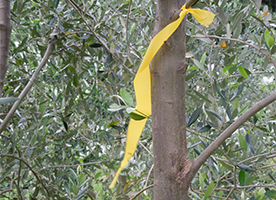
Circular delamination test& study 
Olive fruit just after the profit
In this way, through trial and error, we keep giving this farm all our love and energy.
You can see more of our day-to-day life in real time on our Olive Farm Diary page or on our Facebook.
(Written February 2015)
